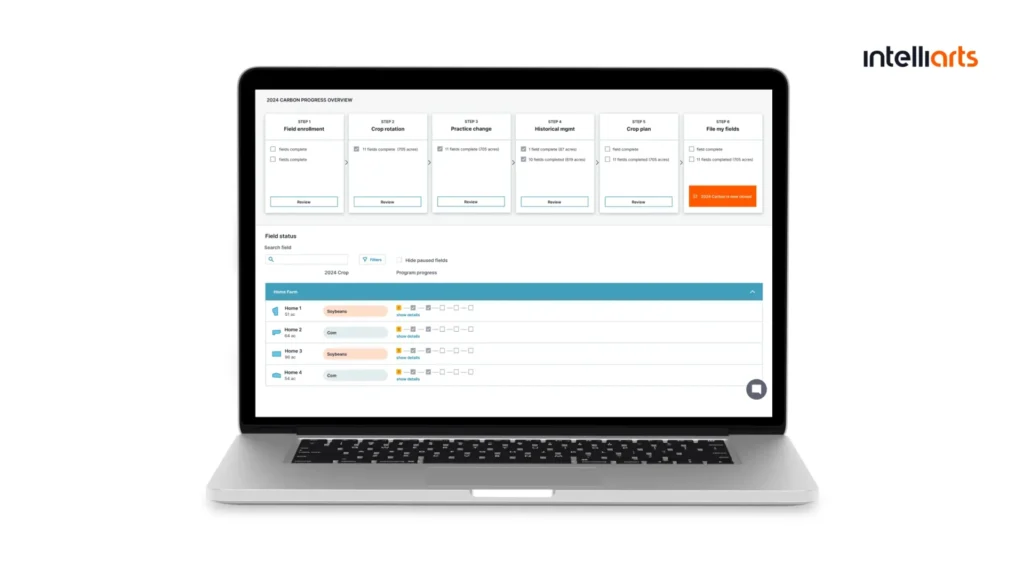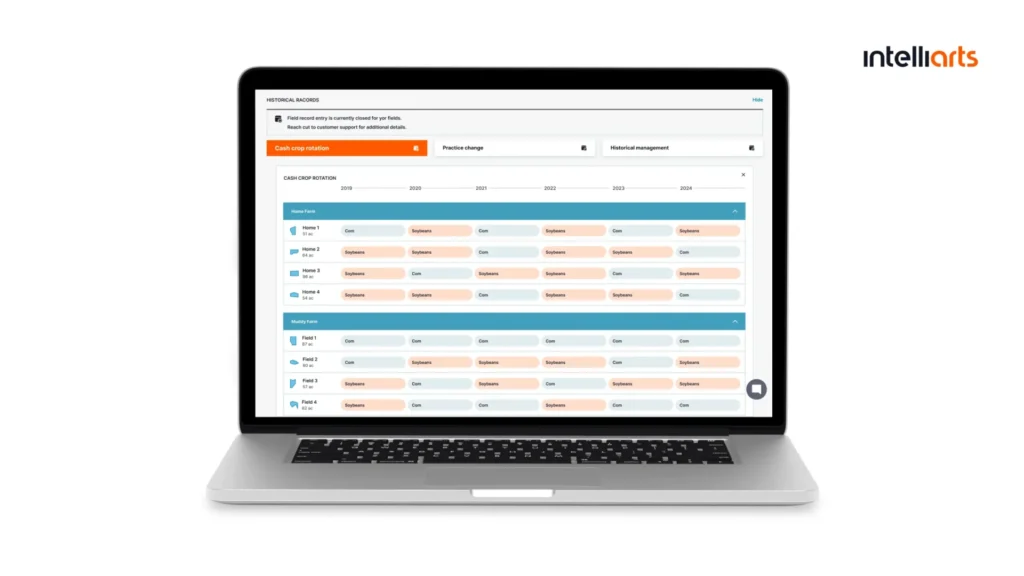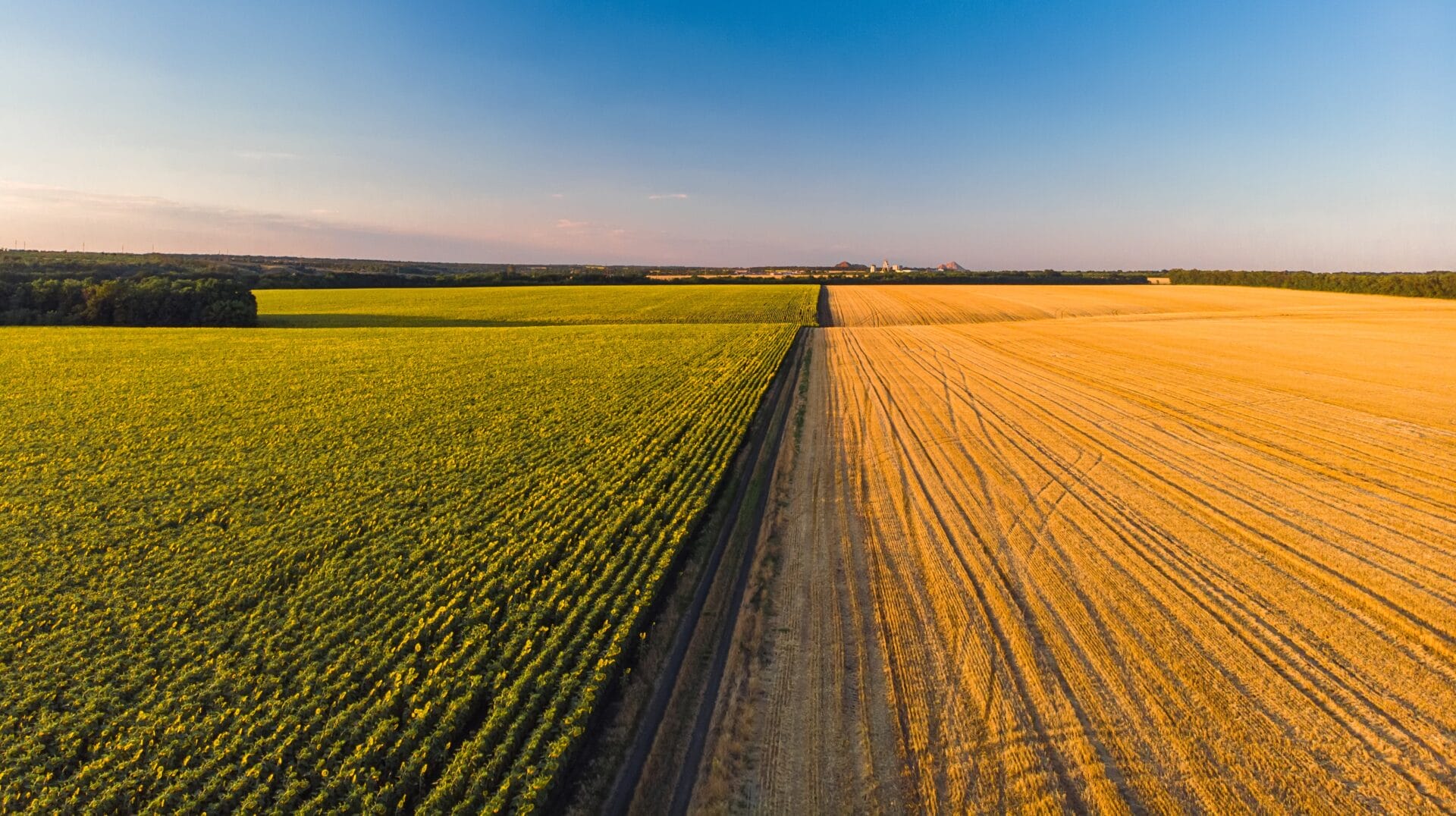Solution Highlights
- Created the lightning solution for automated field data collection and pre-filling using remote sensing and internal API
- Reduced data entry time from weeks to hours or even minutes
- Achieved a nearly 3x increase in final field acres, reaching 2.6M+ across the U.S.
- Gained 80% grower retention rate in one program

About the Project
Customer:
This agritech company (under NDA) is promoting sustainable agriculture through their carbon farming program. This initiative encourages farmers to implement climate-smart practices while also generating verified carbon credits. These credits are then traded on environmental markets, helping businesses reduce emissions and support regenerative farming.
Challenges & Project Goals:
To support growers in enrolling in carbon farming, the company requires detailed field management data — often composed of 3–5 years of historical data records. However, this process has proven to be a significant barrier for our customer to win more farmers to participate and complete their program.
Key challenges included:
- High data burden as growers were asked to provide extensive data, including crop types, planting and harvest dates, and field boundaries. This data, if available, often took weeks to collect and input, discouraging many growers from fully completing the enrollment process.
- Incomplete or inaccurate data: Historical records were often unavailable, inconsistent, or difficult to verify. What’s more, new growers often lacked access to data from their predecessors.
- Low scalability and engagement: The manual effort required to submit detailed records limited program scalability and discouraged potentially new participants.
Recognizing these limitations, the customer wanted to reimagine the data collection process to make enrollment more accessible as well as improve data accuracy.
Solution:
To address the complexity of data collection and improve the grower experience, Intelliarts combined the effort with the customer’s engineering team and developed a so-called lightning software solution.
At the core of this solution is the integration of remote sensing agriculture and the customer’s Best Guess API, i.e. the internal data inference service that uses inputs like satellite imagery (remote sensing), historical patterns, and machine learning (ML) to estimate key agricultural data points. In other words, this helps to auto-detect data such as field boundaries, crop type, cover crop activity, planting and harvesting details and then use it to pre-fill agricultural records. Respectively, users need only to quickly review and confirm the data instead of entering everything manually.
Business Value Delivered:
The use of our lightning system dramatically accelerated the onboarding process, from several weeks down to just a few hours or even minutes. As a result, the number of enrolled acres in the U.S. nearly tripled after the solution was implemented. The customer reached over 3 million acres eligible for carbon credit programs the same year, as compared to only 1 million acres the year before.
Data Analysis, Business Intelligence & Analytics
Technology Solution
The whole purpose of the lightning project was to build a unified and efficient data collection workflow in order to improve the grower experience and win more clients in the long run. Intelliarts partnered with the customer’s engineering team to design and implement the frontend part, while the backend and API services remained fully on the customer’s side.
The integration of remote sensing and the company’s internal Best Guess API made possible automatic pre-filling of grower field data. As mentioned, the system processes satellite imagery through ML-powered farm data tools to infer and pre-populate grower records. The inferred data stands for the information that is not entered manually by the grower. Instead, it’s automatically generated based on satellite images, historical patterns, and ML models.
In cases where the system cannot detect information with the help of remote sensing or infer it using logic and data (known as LED, logic-enabled detection), the solution still guides users through a simplified data entry process. Specifically, the streamlined interface helps users to input and validate only the necessary information. For example, when a user provides just the crop type and planting date, the system can infer compatible chemical applications and timelines.
The solution was implemented in 10 iterative steps, each aimed at improving how users collect and manage field data. Specifically, we:
- Removed unnecessary questions at the operational level to reduce user effort.
- Enabled users to create crop plans starting with a crop type and planting date and assign these to relevant fields.
- Introduced visibility into which fields still required data to be filled. We also allowed users to create historical crop plans and track completion statuses.
- Prepared version 1 for internal testing and feedback collection.
- Added support for a full range of data collection events, an MVP dashboard, and initial validation logic.
- Enabled growers to report changes in their farming practices and ensured that the system automatically checks whether each field meets the requirements for program participation.
- Made it possible to upload supporting documents and track field statuses. The system also introduced validation to prevent users from assigning incompatible crop plans and attestations. If needed, users could upload documentation to override validation errors.
- Finalized workflows for data entry, validation, attestation, and document upload. Users could now copy crop plans, report non-harvest outcomes and fallow periods, and handle special cases like double cropping. We also introduced the MVP for the evidence review queue and partner dashboard.
- Fully integrated the Best Guess API with field assignments and data validation. We also finished the evidence upload feature and worked on improving more complex user actions, such as editing, unassigning, or reassigning crop plans after they’ve already been submitted.
- Enabled returning growers from 2024 source programs to reuse crop plan data and benefit from the use of lightning to test the solution.
Throughout all these stages, Intelliarts worked closely with the customer’s team to ensure the frontend aligned seamlessly with backend APIs, data models, and evolving validation logic.
Business Outcomes
Our team has contributed to a dramatic transformation in how this agriculture company collects and manages field data through a scalable grower data collection platform. What once took growers weeks to complete manually, now happens in a matter of hours or even minutes. Thanks to automated pre-filling and streamlined workflows, growers now save time and reduce frustration.
The value of this work is reflected in the growers’ feedback. Here is what one of the companies commented on the lightning solution:
“This is a complex effort with scale to boot, and from the customer’s perspective, executed smoother than expected.”
In the long run, the implementation of the lightning solution also led to impressive business growth and measurable program success for our customer’s business:
- Over 2.6 million acres of final field in the USA, representing a nearly x3 increase year-over-year
- More than 1 million salable carbon credits generated the next year after the release
- 80% retention rate in one of the programs
- 900 thousand acres reactivated — fields that had never filed or skipped filing
- 55% conversion rate of new acres to final filed
- Data collection time reduced from several weeks to just hours or even minutes per grower
- Better position of the customer as a leader in farming enrollment solutions, which support the generation of carbon credits for farmers at scale













